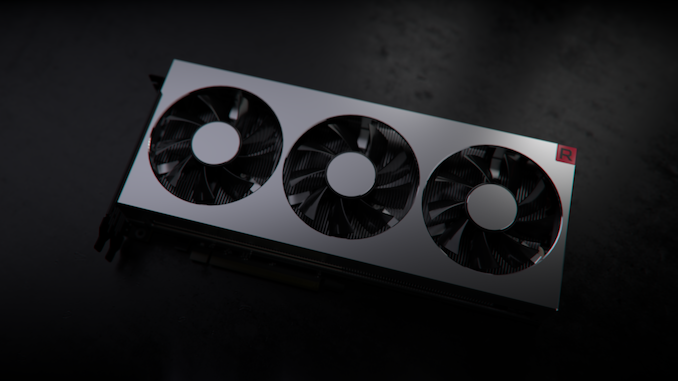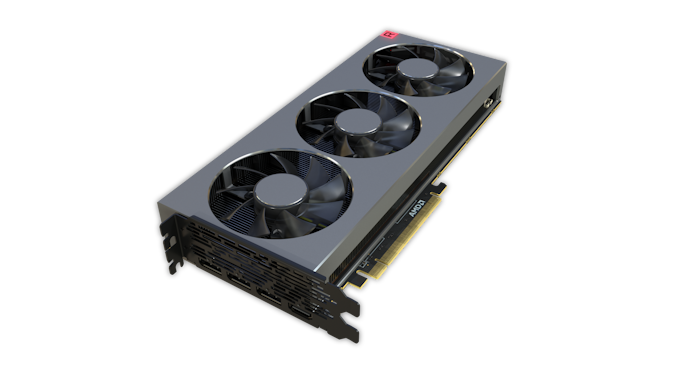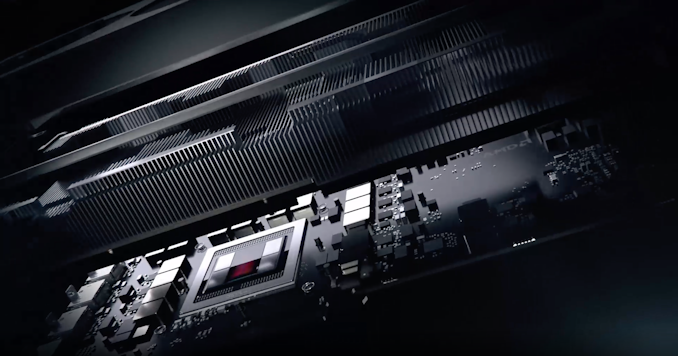The AMD Radeon VII Review: An Unexpected Shot At The High-End
by Nate Oh on February 7, 2019 9:00 AM ESTMeet The Radeon VII
First things first is the design and build, and for the AMD Radeon VII, we've already noticed the biggest change: an open air cooler. Keeping the sleek brushed metal look of the previous RX Vega 64 Limited Edition and Liquid variants, they've forgone the blower for a triple axial fan setup, the standard custom AIB configuration for high-end cards.
While NVIDIA's GeForce RTX series went this way with open-air dual-fan coolers, AMD is no stranger to changing things up themselves. Aside from the RX Vega 64 Liquid, the R9 Fury X's AIO CLC was also quite impressive for a reference design. But as we mentioned with the Founders Edition cards, moving away from blowers for open-air means adopting a cooling configuration that can no longer guarantee complete self-cooling. That is, cooling effectiveness won't be independent of chassis airflow, or lack thereof. This is usually an issue for large OEMs that configure machines assuming blower-style cards, but this is less the case for the highest-end cards, which for pre-builts tend to come from boutique system integrators.
The move to open-air does benefit higher TDP, and at 300W TBP the Radeon VII is indeed one for higher power consumption. While 5W more than the RX Vega 64, there's presumably more localized heat with two more HBM2 stacks, plus the fact that the same amount of power is being consumed but on a smaller die area. And at 300W TBP, this would mean that all power-savings from the smaller process were re-invested into performance. If higher clockspeeds are where the Radeon VII is bringing the majority of its speedup over RX Vega 64, then there would be little alternative to abandoning the blower.
Returning to the Radeon VII build, then, the card naturally has dual 8-pin PCIe connectors, but lacks the BIOS switch of the RX Vega cards that toggled a lower-power BIOS. And with the customary LEDs, the 'Radeon' on the side lights up, as does the 'R' cube in the corner.
In terms of display outputs, there are no surprises here with 3x DisplayPort and 1x HDMI.
A few teardowns of the card elsewhere revealed a vapor chamber configuration with a thermal pad for the TIM, rather than the usual paste. While lower-performing in terms of heat transfer, we know that the RX Vega cards ended up having molded and unmolded package variants, requiring specific instructions to manufacturers on the matter. So this might be a way to head off potential ASIC height difference issues.














289 Comments
View All Comments
Alistair - Thursday, February 7, 2019 - link
Because everyone is already playing Anthem at 4k 60fps with a $400 card? Ray tracing is totally useless and we need way more rasterization performance per dollar than we have right now. Give me a 7nm 2080 ti without the RT cores for $699 and then we'll talk.eva02langley - Friday, February 8, 2019 - link
Fair, the main objective of gaming GPU are shaders per $. Gameworks gimmick are not something I call a selling factor... and Nvidia is forced to cook their books because of it.RSAUser - Thursday, February 7, 2019 - link
Why are you adding the Final Fantasy benchmark when it has known bias issues?Zizy - Thursday, February 7, 2019 - link
Eh, 2080 is slightly better for games and costs the same, while unfortunately MATLAB supports just CUDA so I can't even play with compute.Hul8 - Thursday, February 7, 2019 - link
On page 19, the "Load GPU Temperatur - FurMark" graph is duplicated.Ryan Smith - Thursday, February 7, 2019 - link
Thanks. The FurMark power graph has been put back where it belongs.schizoide - Thursday, February 7, 2019 - link
Man, I've never seen such a hostile response to an Anandtech article. People need to relax, it's just a videocard.I don't see this as a win for AMD. Using HBM2 the card is expensive to produce, so they don't have a lot of freedom to discount it. Without a hefty discount, it's louder, hotter, and slower than a 2080 at the same price. And of course no ray-tracing, which may or may not matter, but I'd rather have it just in case.
For OpenCL work it's a very attractive option, but again, that's a loser for AMD because they ALREADY sold this card as a workstation product for a lot more money. Now it's discounted to compete with the 2080, meaning less revenue for AMD.
Even once the drivers are fixed, I don't see this going anywhere. It's another Vega64.
sing_electric - Thursday, February 7, 2019 - link
There's still a lot of people for whom a Radeon Instinct was just never going to happen, INCLUDING people who might have a workstation where they write code that will mostly run on servers, and it means you can run/test your code on your workstation with a fairly predictable mapping to final server performance.As Nate said in the review, it's also very attractive to academics, which benefits AMD in the long run if say, a bunch of professors and grad students learn to write ML/CL on Radeon before say, starting or joining companies.
schizoide - Thursday, February 7, 2019 - link
Yes, it's attractive to anyone who values OpenCL performance. They're getting workstation-class hardware on the cheap. But that does devalue AMD's workstation productline.Manch - Thursday, February 7, 2019 - link
Not really. The instinct cards are still more performant. They tend to be bought by businesses where time/perf is more important than price/perf.